Explore the Benefits of Using a Membrane Switch in Modern Devices
Wiki Article
Comprehending Membrane Changes: The Key to Durable and Trustworthy Controls

What Are Membrane Buttons?
Membrane buttons are a sophisticated option in the realm of user interface technology, combining capability and design seamlessly. These devices function as an interface in between customers and electronic systems, incorporating a number of components right into a compact layout. Normally created from adaptable, thin layers of products, membrane buttons are designed to react to touch, enabling users to interact with equipment and digital devices effectively.The main components of a membrane button consist of a printed circuit layer, graphic overlay, and a spacer layer that stops unexpected activation. The graphic overlay can be customized to show brand identity or customer preferences, enhancing aesthetics while making sure usability. Membrane buttons are generally used in different applications, consisting of clinical gadgets, customer electronic devices, and industrial tools, owing to their toughness and resistance to ecological factors such as dampness and dirt.
Among the key advantages of membrane buttons is their capability to withstand deterioration, making them perfect for high-traffic atmospheres. Furthermore, they are light-weight and call for very little room, enabling cutting-edge styles in product development. Overall, membrane switches over represent a sensible and efficient choice for modern-day digital user interfaces, marrying modern technology with user-centric style concepts.
Exactly How Membrane Layer Switches Over Job
The procedure of membrane layer switches over joints on a simple yet reliable system that translates individual input into digital signals. When a user presses the switch, the top layer warps, permitting a conductive element in the circuit layer to make contact with a matching conductive pad on the bottom of the visuals overlay.The style of membrane layer buttons can vary, but they often include domes or tactile components to provide responses to the individual, boosting the total experience - membrane switch. The materials utilized in membrane layer buttons, such as polyester or polycarbonate, add to their longevity and resistance to environmental variables, including dampness and dirt. The published circuits are generally encapsulated, which secures them from wear and tear over time.
Advantages of Membrane Buttons

In addition, membrane switches are understood for their longevity. Constructed from durable products, they are immune to dust, wetness, and physical wear, which significantly prolongs their life-span contrasted to traditional mechanical buttons. This toughness makes them particularly suitable for high-traffic settings and applications calling for durability.
An additional considerable benefit is the simplicity of cleansing and maintenance. The smooth surface of membrane layer changes decreases dirt accumulation and is commonly unsusceptible spills, making them ideal for setups that need constant sanitization.
Furthermore, membrane layer switches offer a streamlined profile, leading to a thinner style that can be incorporated right into various gadgets without including mass. This feature not just improves the aesthetic appeal yet likewise contributes to a more ergonomic item design.
Applications of Membrane Layer Switches
User-friendly and flexible, membrane layer buttons find applications throughout a vast array of sectors, consisting of clinical tools, consumer electronic devices, and industrial tools. In the clinical field, these buttons are integral to devices such as diagnostic equipment, patient surveillance systems, and mixture pumps, where integrity and simplicity of cleansing are vital. Their capacity to endure rough atmospheres and keep functionality makes them optimal for such applications.
In customer electronics, membrane layer switches are used in items like microwaves, cleaning devices, and push-button controls - membrane switch. Their smooth style allows for intuitive interface, enhancing the total user experience while supplying sturdiness and resistance to tear and wear
Industrial equipment likewise gains from membrane switches, specifically in control panels for machinery and automation systems. These switches use protection versus dirt and moisture, ensuring constant efficiency in tough atmospheres. Their personalized attributes permit suppliers to tailor them to particular operational needs, enhancing performance and performance.
Picking the Right Membrane Change
When selecting a membrane layer button, it is necessary to consider various factors that influence efficiency and viability for specific applications. The key considerations include environmental problems, responsive responses, durability, and layout requirements.
First, evaluate the operating setting; buttons subjected to wetness, chemicals, or severe temperatures call for certain materials to make certain longevity and capability. Next, review the requirement for responsive comments. Depending on individual communication, some applications might gain from a responsive action to confirm activation, while others might prefer a non-tactile layout for visual factors.
Toughness is an additional essential factor; membrane switches should be developed to hold up against frequent click here for more use, impacts, and abrasion. Guarantee the picked button can sustain the expected lifecycle, particularly in high-usage situations.

Conclusion
In conclusion, membrane layer changes serve as crucial components in the style of long lasting and trustworthy control systems throughout numerous industries. The flexibility of membrane switches enables for customized options that fulfill specific operational demands, reinforcing their significance in modern technology.
Membrane layer changes represent a crucial element of modern-day user interface style, mixing functionality with strength in different applications.Membrane layer switches are an advanced remedy in the realm of individual interface technology, integrating performance and layout seamlessly. Commonly constructed from adaptable, slim layers of materials, membrane switches are created to react to touch, enabling customers to communicate with equipment and electronic tools successfully.
The layout of membrane switches can differ, yet they usually include domes or tactile elements to give feedback to the customer, enhancing the overall experience.In conclusion, membrane layer switches offer as important components in the design of trustworthy and resilient control systems throughout different sectors.
Report this wiki page